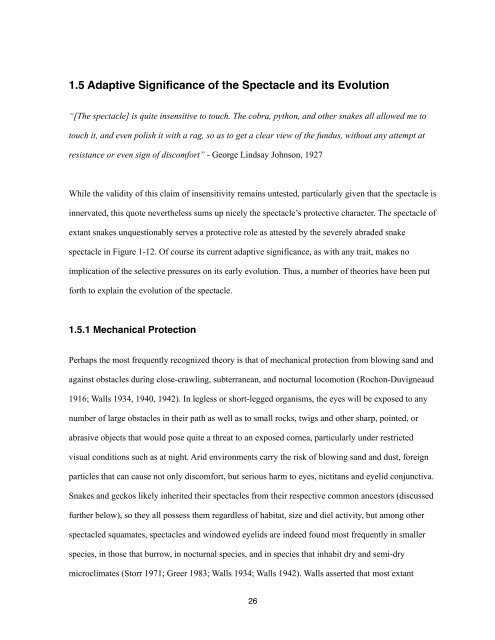Chapter 1, The Reptilian Spectacle - UWSpace - University of ...
Chapter 1, The Reptilian Spectacle - UWSpace - University of ...
Chapter 1, The Reptilian Spectacle - UWSpace - University of ...
Create successful ePaper yourself
Turn your PDF publications into a flip-book with our unique Google optimized e-Paper software.
1.5 Adaptive Significance <strong>of</strong> the <strong>Spectacle</strong> and its Evolution<br />
“[<strong>The</strong> spectacle] is quite insensitive to touch. <strong>The</strong> cobra, python, and other snakes all allowed me to<br />
touch it, and even polish it with a rag, so as to get a clear view <strong>of</strong> the fundus, without any attempt at<br />
resistance or even sign <strong>of</strong> discomfort” - George Lindsay Johnson, 1927<br />
While the validity <strong>of</strong> this claim <strong>of</strong> insensitivity remains untested, particularly given that the spectacle is<br />
innervated, this quote nevertheless sums up nicely the spectacle’s protective character. <strong>The</strong> spectacle <strong>of</strong><br />
extant snakes unquestionably serves a protective role as attested by the severely abraded snake<br />
spectacle in Figure 1-12. Of course its current adaptive significance, as with any trait, makes no<br />
implication <strong>of</strong> the selective pressures on its early evolution. Thus, a number <strong>of</strong> theories have been put<br />
forth to explain the evolution <strong>of</strong> the spectacle.<br />
1.5.1 Mechanical Protection<br />
Perhaps the most frequently recognized theory is that <strong>of</strong> mechanical protection from blowing sand and<br />
against obstacles during close-crawling, subterranean, and nocturnal locomotion (Rochon-Duvigneaud<br />
1916; Walls 1934, 1940, 1942). In legless or short-legged organisms, the eyes will be exposed to any<br />
number <strong>of</strong> large obstacles in their path as well as to small rocks, twigs and other sharp, pointed, or<br />
abrasive objects that would pose quite a threat to an exposed cornea, particularly under restricted<br />
visual conditions such as at night. Arid environments carry the risk <strong>of</strong> blowing sand and dust, foreign<br />
particles that can cause not only discomfort, but serious harm to eyes, nictitans and eyelid conjunctiva.<br />
Snakes and geckos likely inherited their spectacles from their respective common ancestors (discussed<br />
further below), so they all possess them regardless <strong>of</strong> habitat, size and diel activity, but among other<br />
spectacled squamates, spectacles and windowed eyelids are indeed found most frequently in smaller<br />
species, in those that burrow, in nocturnal species, and in species that inhabit dry and semi-dry<br />
microclimates (Storr 1971; Greer 1983; Walls 1934; Walls 1942). Walls asserted that most extant<br />
26
















